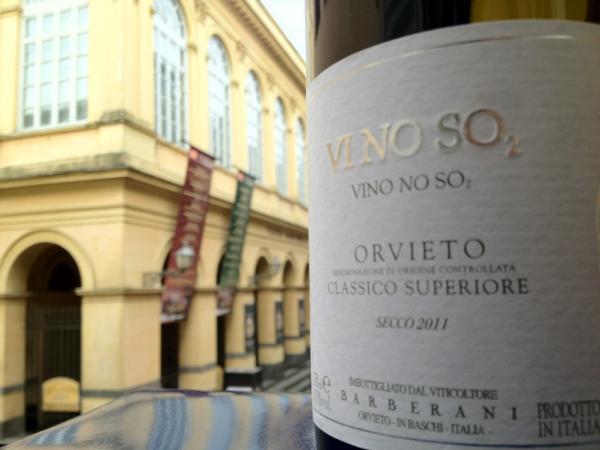Special “Orvieto Classico”
Barrels of “Orvieto Classico”, papal city, were regularly sent to the refectories of the prelates and of the noble men of Rome; and considering that the donations were at that time common means in order to get the benevolence of powerful protectors, the city was worried about the production that should be important and the quality of the product excellent.
Grapes: (in decreasing percentage) Trebbiano toscano, (Procanico Biancone) Verdicchio (Verdello) Canaiolo (Trupeccio) Grechetto.
Color: Yellow glazed clear
Taste: delicate characteristic of grapes infavate, often mellow and sometimes also dry fresh slightly bitter full velvety.
Alcohol content: 12°
Acidity: 7%
Places of production: Orvieto Ficulle Allerona Alviano Lugnano in Teverina and other districts.
Particularity: better if drunk in the year. The Pinturicchio was liking so much the Orvieto classico that he was pretending a delivering without limitation in the contract for the paintings to be executed in the Cathedral; it is adapted to entrées and on a lot of soups, the kinds clearly bitter are naturally to be drunk out of the meal. To be served at 10-12° C.
Special “Orvieto Classico”
Barrels of “Orvieto Classico”, papal city, were regularly sent to the refectories of the prelates and of the noble men of Rome; and considering that the donations were at that time common means in order to get the benevolence of powerful protectors, the city was worried about the production that should be important and the quality of the product excellent.
Grapes: (in decreasing percentage) Trebbiano toscano, (Procanico Biancone) Verdicchio (Verdello) Canaiolo (Trupeccio) Grechetto.
Color: Yellow glazed clear
Taste: delicate characteristic of grapes infavate, often mellow and sometimes also dry fresh slightly bitter full velvety.
Alcohol content: 12°
Acidity: 7%
Places of production: Orvieto Ficulle Allerona Alviano Lugnano in Teverina and other districts.
Particularity: better if drunk in the year. The Pinturicchio was liking so much the Orvieto classico that he was pretending a delivering without limitation in the contract for the paintings to be executed in the Cathedral; it is adapted to entrées and on a lot of soups, the kinds clearly bitter are naturally to be drunk out of the meal. To be served at 10-12° C.
Special “Orvieto Classico”
Barrels of “Orvieto Classico”, papal city, were regularly sent to the refectories of the prelates and of the noble men of Rome; and considering that the donations were at that time common means in order to get the benevolence of powerful protectors, the city was worried about the production that should be important and the quality of the product excellent.
Grapes: (in decreasing percentage) Trebbiano toscano, (Procanico Biancone) Verdicchio (Verdello) Canaiolo (Trupeccio) Grechetto.
Color: Yellow glazed clear
Taste: delicate characteristic of grapes infavate, often mellow and sometimes also dry fresh slightly bitter full velvety.
Alcohol content: 12°
Acidity: 7%
Places of production: Orvieto Ficulle Allerona Alviano Lugnano in Teverina and other districts.
Particularity: better if drunk in the year. The Pinturicchio was liking so much the Orvieto classico that he was pretending a delivering without limitation in the contract for the paintings to be executed in the Cathedral; it is adapted to entrées and on a lot of soups, the kinds clearly bitter are naturally to be drunk out of the meal. To be served at 10-12° C.
Special “Orvieto Classico”
Barrels of “Orvieto Classico”, papal city, were regularly sent to the refectories of the prelates and of the noble men of Rome; and considering that the donations were at that time common means in order to get the benevolence of powerful protectors, the city was worried about the production that should be important and the quality of the product excellent.
Grapes: (in decreasing percentage) Trebbiano toscano, (Procanico Biancone) Verdicchio (Verdello) Canaiolo (Trupeccio) Grechetto.
Color: Yellow glazed clear
Taste: delicate characteristic of grapes infavate, often mellow and sometimes also dry fresh slightly bitter full velvety.
Alcohol content: 12°
Acidity: 7%
Places of production: Orvieto Ficulle Allerona Alviano Lugnano in Teverina and other districts.
Particularity: better if drunk in the year. The Pinturicchio was liking so much the Orvieto classico that he was pretending a delivering without limitation in the contract for the paintings to be executed in the Cathedral; it is adapted to entrées and on a lot of soups, the kinds clearly bitter are naturally to be drunk out of the meal. To be served at 10-12° C.


Comment (0)